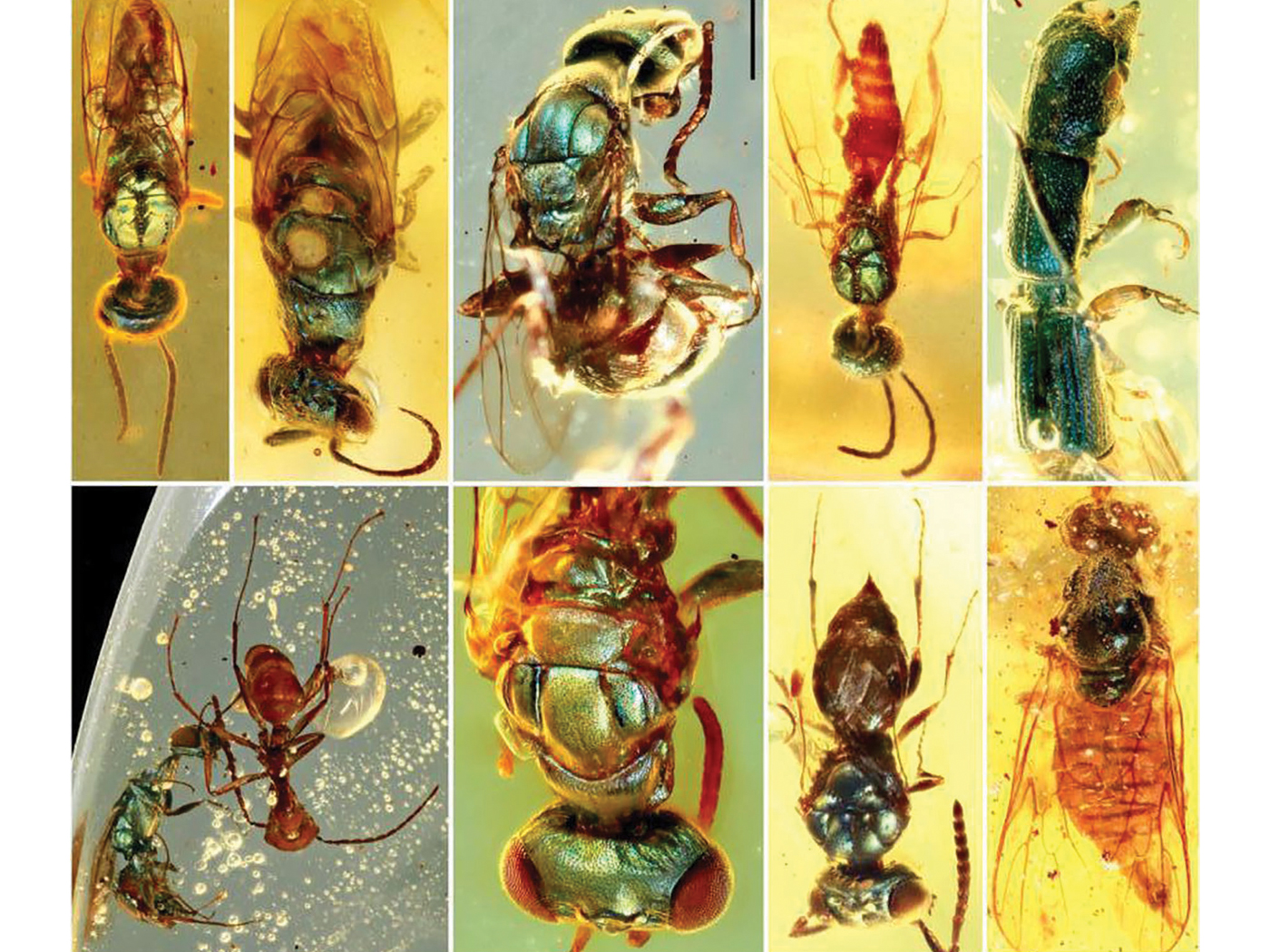Tooth growth patterns in fossils of the mouse-like Jurassic mammal Krusatodon show that it grew slowly and had a “surprisingly long” lifespan compared to mammals of similar size today.1 A paper in Nature describes two “exceptionally complete” Krusatodon specimens, one an adult and the other a juvenile, that were found on Scotland’s Isle of Skye.2 The fossils are dated at 166 million years old (Jurassic) by evolutionary reckoning.2 In contrast, creationists think these fossils are only a few thousand years old and are the remains of creatures that were buried during the Flood of Noah, described in Genesis 6–8.
By counting growth increments in the dental cementum that covers tooth roots, paleontologists concluded that the juvenile, which was still in the process of replacing its baby teeth, was between seven and 24 months old. The adult, with an estimated body mass of 156 grams (5.5 ounces) was about 84 months (seven years) old. An adult age of seven years may not sound like a long lifespan, but it’s important to remember that larger animals usually live longer than smaller animals. So in order to do an “apples-to-apples” comparison of growth rates and longevities, it is important to compare these small fossil mammals to small living mammals, not large ones. In that light, these observations show that Krusatodon grew very slowly and had a “surprisingly long” lifespan compared to small living (or extant) mammals.1
And it wasn’t alone. A 2020 paper showed that the two small Jurassic mammals Morganucodon and Kuehneotherium had even longer lifespans of at least nine and 14 years.3 This result is shown graphically in the above figure.4,5 Elsa Panciroli, paleobiologist and lead author on the Nature paper, alluded to this earlier research in a statement:
“Recent work has shown that the first mammals in the Late Triassic and Early Jurassic lived much longer than similar sized mammals today – up to 14 years old. If you compare that with today’s shrews of similar body mass, some of which live to just over a year, this is a huge difference in lifespan.”6
This research should be of interest to Bible-believing Christians because, as chronicled in Genesis 5, humans in the pre-Flood world were experiencing much greater lifespans. Moreover, the advanced ages of the Genesis 5 patriarchs at the births of their sons strongly suggest delayed sexual maturation and possible delayed skeletal maturation, too. The Bible gives no hint that this amazing longevity was in any way supernatural.
Creationists have suggested a number of possible scientific causes for this longevity (fewer genetic mistakes, different atmospheric composition, etc.). Like the genomes in pre-Flood humans, pre-Flood animal genomes likely also had few genetic “mistakes.” Both humans and animals were breathing the same air, and both pre-Flood humans and animals had access to abundant food, etc. Thus, it is likely that animals in the pre-Flood world were also experiencing much greater longevity. The results of this Krusatodon research are consistent with that expectation, suggested by creation researchers Donald Patten and Greg Beasley decades ago.7,8
Until now, counting growth bands in teeth has rarely been used to estimate ages for Jurassic and Cretaceous mammals because it required partial destruction of the fossil material. However, a newer imaging technique called phase-contrast X-ray synchrotron radiation microtomography (PPC-SRμCT) has overcome this difficulty, allowing for noninvasive counting of growth bands in teeth without destroying the original fossil material.3 This raises the possibility that this technique could conceivably reveal even more evidence for great mammal longevity in the pre-Flood world!
Preliminary evidence of possible greater longevity in fossil animals was presented at the 2023 International Conference on Creationism.9 Since then, ICR follow-up research has strengthened this preliminary argument and revealed direct and indirect evidence of greater longevity in the fossil bivalve Crassostrea10,11 and indirect evidence of greater longevity in giant fossil sharks.12 Moreover, research documenting similar evidence in other fossil creatures has already been submitted for peer review.
Despite opposing claims by some evangelicals, the remarkable longevities recorded in the early chapters of Genesis should be taken at face value, and scientific evidence is accumulating that this longevity characterized, not just humans living in the pre-Flood world, but many animals, as well.
References
-
Laura Baisas, “Baby Teeth Reveal Surprisingly Long Lifespans of Small Jurassic Mammals,” Popular Science, July 24, 2024, https://www.popsci.com/science/jurassic-
mammal-teeth/. - Elsa Panciroli et al., “Jurassic Fossil Juvenile Reveals Prolonged Life History in Early Mammals,” Nature (2024).
- Elis Newham et al., “Reptile-Like Physiology in Early Jurassic Stem-Mammals,” Nature Communications 11, no. 5121 (2020).
- The axes on the graph are logarithmic, meaning that each tick mark represents a number 10 times greater than the previous tick mark. This is a space-saving feature for graphing numbers that cover a wide range.
- Microcebus murinus, Tachyglossus aculeatus, Dasycercus cristicauda, and Meriones unguiculatus, whose lifespans are also shown in the figure, are small living mammals with higher-than-normal lifespans.
-
Ruth Schuster, “Early Mammals Lived Longer. Why Can’t We?” Haaretz, July 24, 2024, https://www.haaretz.com/science-and-heal
th/2024-07-24/ty-article/early-mammals-l
ived-longer-why-cant-we/00000190-e414-d2
bf-a7f9-f4f7a84a0000. - Donald W. Patten, “The Longevity Accounts in Ancient History,” Creation Research Society Quarterly 19, no. 1 (1982): 40–52.
- Greg Beasley, “Pre-flood Giantism: A Key to the Interpretation of Fossil Hominids and Hominoids,” Journal of Creation 4, no. 1 (1990): 5–55.
- Leo Hebert III, “Allometric and Metabolic Scaling: Arguments for Design . . . and Clues to Explaining Pre-Flood Longevity?” Proceedings of the International Conference on Creationism 9, no. 18 (2023): 206–227.
- Jake Hebert et al., “Crassostrea Oyster Fossils Show Evidence of Extreme Longevity,” Creation Research Society Quarterly 60, no. 3 (2024): 171–190.
- Jake Hebert, “Oysters and Pre-Flood Longevity,” Acts & Facts, May/June 2024, 19.
- Jake Hebert, “Giantism and Delayed Maturation in Fossil Sharks: Evidence for Extreme Longevity?” Creation Research Society Quarterly 60, no. 4 (2024): 267–283.
Stage image: Wild lifespan (dot plot chart)
Stage image credit: Copyright © Newham, E., Gill, P.G., Brewer, P. et al. Used in accordance with federal copyright (fair use doctrine) law. Usage by ICR does not imply endorsement of copyright holder.
* Dr. Jake Hebert is a research associate at the Institute for Creation Research and earned his Ph.D. in physics from the University of Texas at Dallas.













